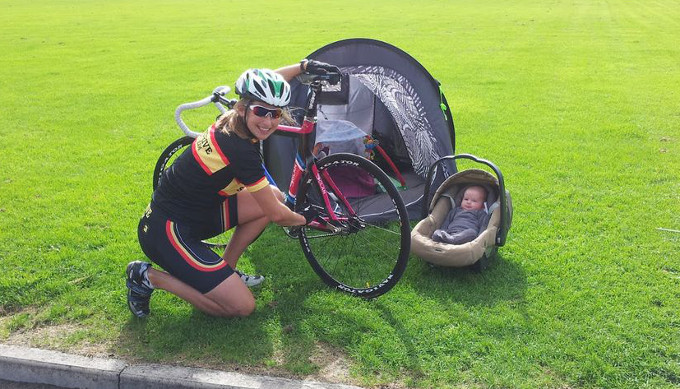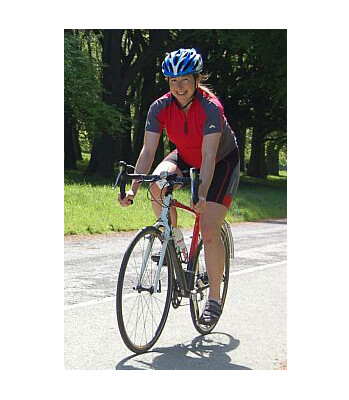
Susie Mitchell won the UCI Track Cycling Masters World Championships back in 2013, just 4 months after giving birth to her daughter. Making the decision to continue training while pregnant was not an easy one due to a severe lack of information available. After much research and of course her own personal experience, Susie throws her two cents at whether exercising while pregnant, especially cycling is harmful to the baby.
Being a bit of a cycling nut, I was reluctant to hang up my wheels during my pregnancy. In the very early stages, I continued to cycle while pregnant. There was nobody to tell me any different and to be honest, I wasn’t asking. Denial actually worked very well for a while, however, after a bit of a scare including a near miss when tearing down a hill on my mountain bike made me sit up and take notice.
After the scare, I decided it was time to face the music. When the line appeared on the pregnancy test, confirming that I was indeed, two months pregnant, as I’d suspected, I decided the mountain biking had to go, or at least riding on steep, technical trails. Cycling safely when pregnant is about risk minimisation.
 Although mountain biking had to take a back seat, I felt confident I could continue on my road bike cycling while pregnant, but felt the need to get some advice and support on how to do so. I knew the general attitude out there for pregnant women was rather ‘anti-bike’, so cunningly I picked an easy target to ask for help, my coach.
Although mountain biking had to take a back seat, I felt confident I could continue on my road bike cycling while pregnant, but felt the need to get some advice and support on how to do so. I knew the general attitude out there for pregnant women was rather ‘anti-bike’, so cunningly I picked an easy target to ask for help, my coach.
He was already well on board as we were working towards competing in the world track cycling masters the following October. I came clean one evening after training, and it took no time convincing him that I needed to keep up a reasonable amount of time in the saddle if I was to have any chance in competing the following autumn. He could see how determined I was so had no option but to help me.
Not having a clue when it came to pregnant women, let alone ones who wanted to ride their bikes, my coach turned to a friend of his, an elite cyclist who had trained through her pregnancy, for advice. Of course exercise while pregnant for everyone is different and what you can do at any stage relates to the size and position of your bump.
After the initial shock of being pregnant subsided, I went on a mission to find reasonable guidelines as to what I could do in terms of exercise and training. As this was my first pregnancy, I didn’t know anything about being ‘with child’ and exercising, but by and large what I had heard wasn’t too encouraging.
Advice friends gave me for cycling while pregnant had been given rang through my head. One close friend, a passionate hill runner was recommended to “give up running, just in case,” by her GP.
Another suggested “easy swimming is fine” assuring me I could “go for brisk walks every day, instead of running and cycling.” This was not what I wanted to hear; brisk walking would not produce the levels of exercise-induced endorphins I was accustomed to.
I wondered what the hell all the elite athletes at the top end of the scale did when they fell pregnant?
Surely the likes of Paula Radcliff didn’t just swap running 100 miles a week for easy walks and gentle swimming. I’m sure I heard somewhere that Paula did in fact run a marathon while 7 months pregnant in a pretty impressive time!
In my search for information on cycling while pregnant I turned to the trusty Internet. This turned out to be a bit of a mission. I suspected that the information must be out there somewhere and that most pregnant female athletes must be following some sort of training programs, but any concrete reference as to what they were actually doing remained elusive.
Googling word combinations such as “athlete, exercise and pregnancy” yielded results with wildly different advice. Everyone who wrote anything seemed to have an opinion. I couldn’t quite believe how polarized some of these views were on exercising while pregnant. There seemed to be precious little in the way of advice that wasn’t ultra conservative.
At this point, feeling deflated at not finding what I wanted, I put the brakes on and took a different tack. Being a scientist and also a veterinarian I decided the best approach would to conduct my own scientific literature review to look for good robust peer-reviewed journal articles from a range of physiology and medical journals for answers.
The results produced slightly less conflicting views on exercise during pregnancy, but I still felt they were all pretty cautious in terms of advice. The standard set of guidelines that are referred to in most publications were set by the American College of Obstetricians and Gynecologists (ACOG) first published in the 1980’s.
These have been recently revised but still remain pretty conservative. ACOG recommend that pregnant women who are free of any complications engage in at least 30 minutes of moderate physical activity per day on most days of the week.
Research to investigate the effects of high intensity exercise on the foetus appears to be particularly fraught with ethical complications, and therefore the number of studies investigating such could nearly be counted on one hand with very few participants in each study.
It is worth mentioning here that based on these limited studies there doesn’t appear to be any evidence to indicate that exercise at higher intensities produces any harmful effects on the foetus, which I found particularly interesting. Despite this lack of evidence, one of the most common suggestions when you seek advice about what level you can exercise at during pregnancy is to reduce the intensity.
Unsurprisingly, the precautionary principle is applied across the board when it comes to pregnancy. Any woman who has ever undergone a pregnancy will know this to be true, not just when it comes to exercise. Everything from supplements to medicines to foods and drink, anything that has not been proved conclusively beyond reasonable doubt to be totally harmless – well you better not. Just in case that is!
No one is going to advise a pregnant woman otherwise for fear of the consequences, if there happen to be any. That’s why taking the approach of listening to your body is probably the best advice anyone can get when wondering what they should and shouldn’t do during their pregnancy.
For my part I was lucky and the bump didn’t expand sufficiently to stop me. I was able to cycle while pregnant right up to the end. I treated every cycle as if it was my last, not knowing whether I would able for it the following week.
Time ticked by and all of a sudden I found myself out on a 50km spin on my due date. I decided at that point it was time to call it a day so it was without any regrets I said goodbye to my road bike for a few weeks. I got my sneaky fix from the odd spinning class during the ten days I was overdue.
From all of the research I’ve conducted, to cut a long story short, if I could offer one bit of advice it would be: Listen to your body, if it feels ok for you – go for it!





